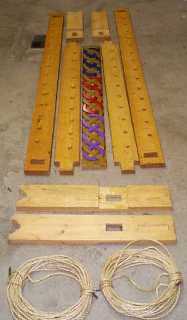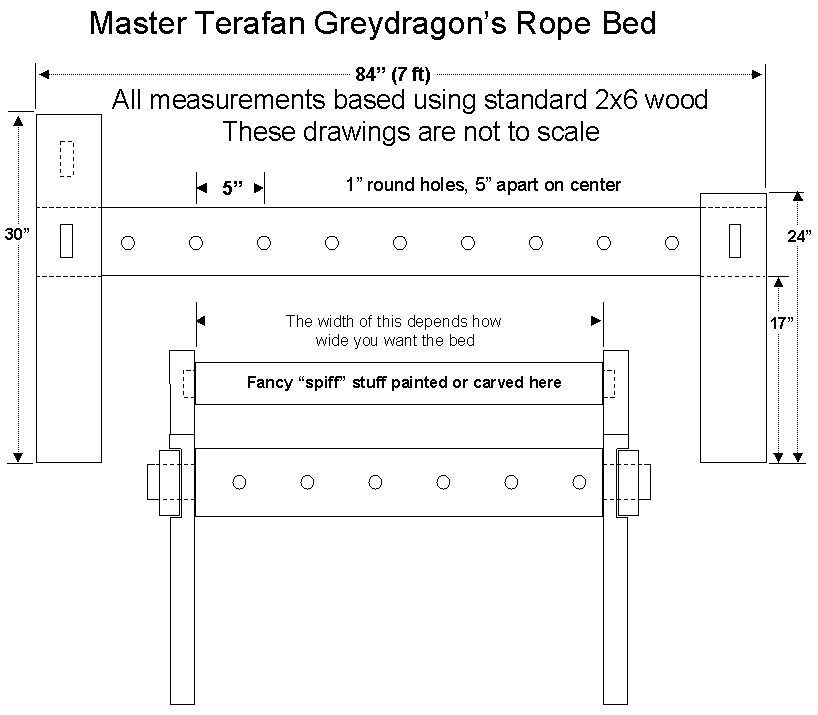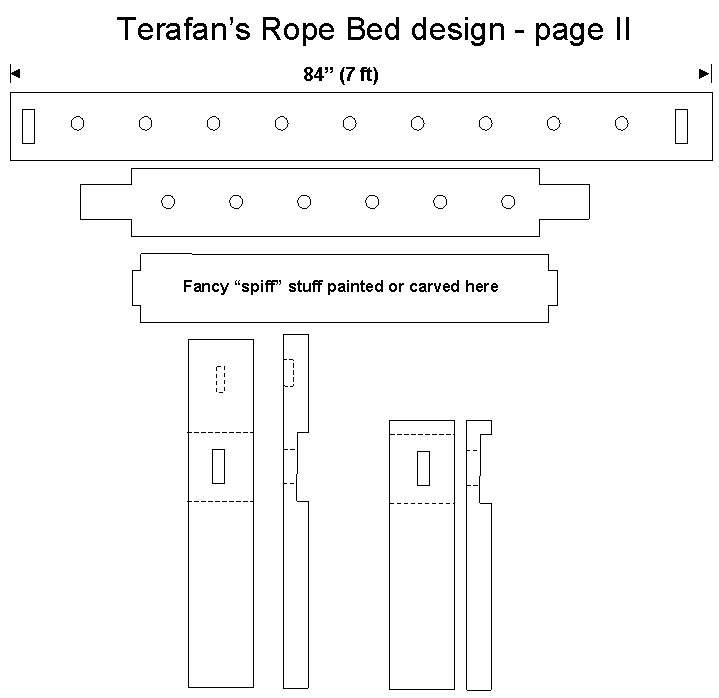A Period Rope Bed
Some time ago, several of our friends told us
about a period picture one of them had found, a 13th c. Byzantine
ivory showing a rope bed they made a version of that bed sized for
a small child. It turned out to be ridiculously easy
to make--about half an hour for me to build the bed, plus another
hour or so for me and my lady wife to lace it.
The basic problem with rope beds is that unless
the rope is very taut, they sag. The solution in this design is to
have the mesh of ropes fasten not to the food of the bed but to a
horizontal dowel a little above the foot. You wrap a rope six times
around the dowel and foot and pull. This pulls the dowel towards the
foot with a mechanical advantage of twelve to one (minus substantial
losses from friction and some loss from the rope not being quite a
right angles to the dowel), tightening the bed.
The basic construction is simple. The legs are
oak, 1 5/8" x 1 5/8". The sides are oak dowels, 1" in diameter. Each
leg has two 1" diameter holes drilled into it at right angles to each
other, one a little above the other. The ends of the dowels fit into
the holes.
Materials for the bed as shown
2 legs, oak, 9"x1 5/8 x 1 5/8
2 legs, oak, 18"x1 5/8 x 1 5/8
2 sides, 1" oak dowels, 4' long
2 ends, 1" oak dowels, 2' long
1 end piece, 3/4" oak dowel, 26" long
1/4" manila rope, 1 piece 50' long (for the web),
1 piece 7' long (to wrap around the end piece and the
foot).
Total cost: aprox $60
In addition to its size, this bed differs from the one shown in the
picture in four ways.
1. The legs are plain instead of
ornamental.
2. The legs are proportionally shorter than in the
picture.
3. The legs at the head extend higher than at the
foot. I did it this way with the idea of eventually adding some sort
of headboard.
4. The holes the side dowels plug into are an inch
and a quarter higher on the legs than the holes that the end dowels
plug into. I did it that way because, given the thickness of the
legs, I couldn't get sufficiently deep holes at the same height
without having them run into each other. I don't know whether the
fact that the original appears to have sides and ends at the same
height reflects shallower holes, thicker legs, or artistic
license.
There is a fifth difference in the picture--the
way the tightening rope is wrapped--but by the time you read this I
will have fixed that.
The bed is strong enough to hold our 68
pound son although it is a few inches too short
for him and the side dowels bow in a little when he is in the
bed.
He made two more beds for my two nieces, with
somewhat thicker dowels for the side pieces.
The most recent experiment was an adult sized bed.
I wanted a design that could be widely used by people in the Society,
so limited myself to materials inexpensively available from the local
Home Depot.
 It costs about forty dollars to
It costs about forty dollars to
make, including the rope.
The legs were cut from a single 8 foot long 4x4,
which cost less than seven dollars. With legs that big, I had no
trouble making it with sides and ends at the same height.The head and
foot pieces are 1 1/4" softwood dowels, probably intended as closet
poles, but dowels that size are not really adequate for the side
pieces. I tried using them, and
they bowed quite alarmingly when I lay down in the bed, although they
didn't break. So I replaced them with six foot long softwood 2x2's
(available at about fifty cents a foot) and tapered down the ends to
fit in the holes. That seems to work fairly well. 1 3/4" softwood
dowels would work too, and save you some trouble, but I couldn't find
them in the Home Depot. If you are feeling extravagant and have
access to a good lumberyard, 1 3/4" oak dowels (about $4/foot) would
work even better.
If you want a bed with ornamental legs, check out your local large lumber store, Home
Depot, or equivalent for ornamental table legs, banister pieces, and
the like. Or find a friend with a lathe.
Some time ago, several of our friends told us
about a period picture one of them had found, a 13th c. Byzantine
ivory showing a rope bed they made a version of that bed sized for
a small child. It turned out to be ridiculously easy
to make--about half an hour for me to build the bed, plus another
hour or so for me and my lady wife to lace it.
The basic problem with rope beds is that unless
the rope is very taut, they sag. The solution in this design is to
have the mesh of ropes fasten not to the food of the bed but to a
horizontal dowel a little above the foot. You wrap a rope six times
around the dowel and foot and pull. This pulls the dowel towards the
foot with a mechanical advantage of twelve to one (minus substantial
losses from friction and some loss from the rope not being quite a
right angles to the dowel), tightening the bed.
The basic construction is simple. The legs are
oak, 1 5/8" x 1 5/8". The sides are oak dowels, 1" in diameter. Each
leg has two 1" diameter holes drilled into it at right angles to each
other, one a little above the other. The ends of the dowels fit into
the holes.
Materials for the bed as shown
2 legs, oak, 9"x1 5/8 x 1 5/8
2 legs, oak, 18"x1 5/8 x 1 5/8
2 sides, 1" oak dowels, 4' long
2 ends, 1" oak dowels, 2' long
1 end piece, 3/4" oak dowel, 26" long
1/4" manila rope, 1 piece 50' long (for the web),
1 piece 7' long (to wrap around the end piece and the
foot).
Total cost: aprox $60
In addition to its size, this bed differs from the one shown in the
picture in four ways.
1. The legs are plain instead of
ornamental.
2. The legs are proportionally shorter than in the
picture.
3. The legs at the head extend higher than at the
foot. I did it this way with the idea of eventually adding some sort
of headboard.
4. The holes the side dowels plug into are an inch
and a quarter higher on the legs than the holes that the end dowels
plug into. I did it that way because, given the thickness of the
legs, I couldn't get sufficiently deep holes at the same height
without having them run into each other. I don't know whether the
fact that the original appears to have sides and ends at the same
height reflects shallower holes, thicker legs, or artistic
license.
There is a fifth difference in the picture--the
way the tightening rope is wrapped--but by the time you read this I
will have fixed that.
The bed is strong enough to hold our 68
pound son although it is a few inches too short
for him and the side dowels bow in a little when he is in the
bed.
He made two more beds for my two nieces, with
somewhat thicker dowels for the side pieces.
The most recent experiment was an adult sized bed.
I wanted a design that could be widely used by people in the Society,
so limited myself to materials inexpensively available from the local
Home Depot.
 It costs about forty dollars to
It costs about forty dollars tomake, including the rope.
The legs were cut from a single 8 foot long 4x4,
which cost less than seven dollars. With legs that big, I had no
trouble making it with sides and ends at the same height.The head and
foot pieces are 1 1/4" softwood dowels, probably intended as closet
poles, but dowels that size are not really adequate for the side
pieces. I tried using them, and
they bowed quite alarmingly when I lay down in the bed, although they
didn't break. So I replaced them with six foot long softwood 2x2's
(available at about fifty cents a foot) and tapered down the ends to
fit in the holes. That seems to work fairly well. 1 3/4" softwood
dowels would work too, and save you some trouble, but I couldn't find
them in the Home Depot. If you are feeling extravagant and have
access to a good lumberyard, 1 3/4" oak dowels (about $4/foot) would
work even better.
If you want a bed with ornamental legs, check out your local large lumber store, Home
Depot, or equivalent for ornamental table legs, banister pieces, and
the like. Or find a friend with a lathe.







 .
.